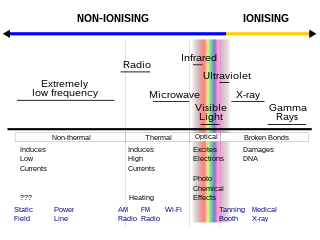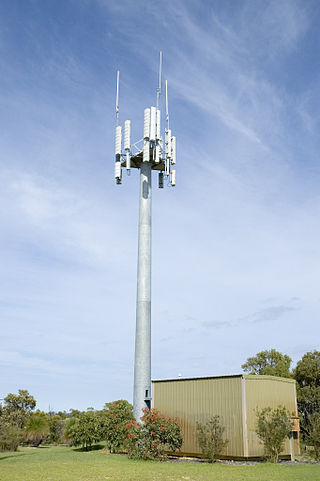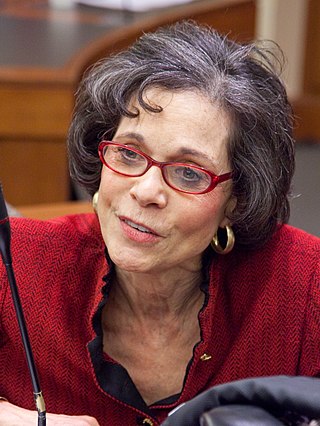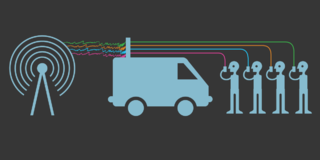Related Research Articles

A brain tumor occurs when abnormal cells form within the brain. There are two main types of tumors: malignant (cancerous) tumors and benign (non-cancerous) tumors. These can be further classified as primary tumors, which start within the brain, and secondary tumors, which most commonly have spread from tumors located outside the brain, known as brain metastasis tumors. All types of brain tumors may produce symptoms that vary depending on the size of the tumor and the part of the brain that is involved. Where symptoms exist, they may include headaches, seizures, problems with vision, vomiting and mental changes. Other symptoms may include difficulty walking, speaking, with sensations, or unconsciousness.

Electromagnetic radiation can be classified into two types: ionizing radiation and non-ionizing radiation, based on the capability of a single photon with more than 10 eV energy to ionize atoms or break chemical bonds. Extreme ultraviolet and higher frequencies, such as X-rays or gamma rays are ionizing, and these pose their own special hazards: see radiation poisoning.

A cell site, cell phone tower, cell base tower, or cellular base station is a cellular-enabled mobile device site where antennas and electronic communications equipment are placed to create a cell, or adjacent cells, in a cellular network. The raised structure typically supports antenna and one or more sets of transmitter/receivers transceivers, digital signal processors, control electronics, a GPS receiver for timing, primary and backup electrical power sources, and sheltering.
Specific absorption rate (SAR) is a measure of the rate at which energy is absorbed per unit mass by a human body when exposed to a radio frequency (RF) electromagnetic field. It is defined as the power absorbed per mass of tissue and has units of watts per kilogram (W/kg).

Mobile telephony is the provision of telephone services to mobile phones rather than fixed-location phones. Telephony is supposed to specifically point to a voice-only service or connection, though sometimes the line may blur.

The antennas contained in mobile phones, including smartphones, emit radiofrequency (RF) radiation ; the parts of the head or body nearest to the antenna can absorb this energy and convert it to heat. Since at least the 1990s, scientists have researched whether the now-ubiquitous radiation associated with mobile phone antennas or cell phone towers is affecting human health. Mobile phone networks use various bands of RF radiation, some of which overlap with the microwave range. Other digital wireless systems, such as data communication networks, produce similar radiation.
Harris Corporation was an American technology company, defense contractor, and information technology services provider that produced wireless equipment, tactical radios, electronic systems, night vision equipment and both terrestrial and spaceborne antennas for use in the government, defense, emergency service, and commercial sectors. They specialized in surveillance solutions, microwave weaponry, and electronic warfare. In 2019, it merged with L3 Technologies to form L3Harris Technologies.
Bioelectromagnetics, also known as bioelectromagnetism, is the study of the interaction between electromagnetic fields and biological entities. Areas of study include electromagnetic fields produced by living cells, tissues or organisms, the effects of man-made sources of electromagnetic fields like mobile phones, and the application of electromagnetic radiation toward therapies for the treatment of various conditions.

Mobile phone use while driving is common but it is considered dangerous due to its potential for causing distracted driving and subsequent crashes. Due to the number of crashes that are related to conducting calls on a phone and texting while driving, some jurisdictions have made the use of calling on a phone while driving illegal in an attempt to curb the practice, with varying levels of efficacy. Many jurisdictions have enacted laws making handheld mobile phone use illegal. Many jurisdictions allow use of a hands-free device. Driving while using a hands-free device has been found by some studies to provide little to no benefit versus holding the device itself and carrying on a conversation. In some cases restrictions are directed only at minors, those who are newly qualified license holders, or to drivers in school zones. In addition to voice calling, activities such as texting while driving, web browsing, playing video games, or phone use in general may also increase the risk of a crash.
Electromagnetic hypersensitivity (EHS) is a claimed sensitivity to electromagnetic fields, to which negative symptoms are attributed. EHS has no scientific basis and is not a recognized medical diagnosis, although it is generally accepted that the experience of EHS symptoms is of psychosomatic origin. Claims are characterized by a "variety of non-specific symptoms, which afflicted individuals attribute to exposure to electromagnetic fields". Attempts to justify the claim that EHS is caused by exposure to electromagnetic fields have amounted to pseudoscience.

Martin Cooper is an American engineer. He is a pioneer in the wireless communications industry, especially in radio spectrum management, with eleven patents in the field.

Devra Lee Davis is an American epidemiologist, toxicologist, and author of three books about environmental hazards. She was founding director of the Center for Environmental Oncology at the University of Pittsburgh Cancer Institute, and is a former professor of epidemiology at University of Pittsburgh Graduate School of Public Health. She has served on several governmental and non-governmental organizations, conducting research and advocacy into effects of pesticides, asbestos, and wireless radiation on human health, especially cancers.
The International Journal of Environmental Research and Public Health is a peer-reviewed open access scientific journal that was established in 2004 and is published by MDPI. The editor-in-chief is Paul B. Tchounwou. The journal covers all aspects of environmental health sciences and public health.

The International Commission on Non-Ionizing Radiation Protection (ICNIRP) is an international commission specialized in non-ionizing radiation protection. The organization's activities include determining exposure limits for electromagnetic fields used by devices such as cellular phones.
Exposure to ionizing radiation is known to increase the future incidence of cancer, particularly leukemia. The mechanism by which this occurs is well understood, but quantitative models predicting the level of risk remain controversial. The most widely accepted model posits that the incidence of cancers due to ionizing radiation increases linearly with effective radiation dose at a rate of 5.5% per sievert; if correct, natural background radiation is the most hazardous source of radiation to general public health, followed by medical imaging as a close second. Additionally, the vast majority of non-invasive cancers are non-melanoma skin cancers caused by ultraviolet radiation. Non-ionizing radio frequency radiation from mobile phones, electric power transmission, and other similar sources have been investigated as a possible carcinogen by the WHO's International Agency for Research on Cancer, but to date, no evidence of this has been observed.

Cellphone surveillance may involve tracking, bugging, monitoring, eavesdropping, and recording conversations and text messages on mobile phones. It also encompasses the monitoring of people's movements, which can be tracked using mobile phone signals when phones are turned on.
Ronald Bruce Herberman was an American physician, immunologist, oncologist, and professor of medicine and pathology who founded the University of Pittsburgh Cancer Institute (UPCI), a National Cancer Institute-designated Comprehensive Care Center in 1984. He helped discover natural killer cells capable of killing cancer. He became well known outside the medical community in 2008 for his public warning about the potential health impacts of mobile telephones and recommending a reduction in their use.
Lennart Hardell, is a Swedish oncologist and professor at Örebro University Hospital in Örebro, Sweden. He is known for his research into what he says are environmental cancer-causing agents, such as Agent Orange, and has said that cell phones increase the risk of brain tumors.
The Interphone study was a set of international case-control studies conducted with the aim of determining whether mobile phone use increased the risk of certain tumors, namely, glioma, meningioma, and schwannoma. The study was conducted by the International Agency for Research on Cancer (IARC) in thirteen different countries, at a cost of $24 million. About fifty scientists worked on the study, which was the largest case-control study conducted on the association between mobile phones and cancer as of 2014. The study's results, published in 2010, indicated that mobile phone use did not increase the risk of tumors among most cell phone users, with the possible exception of an increased risk among the 10% of users who used their cell phones the most.

The COVID-19 pandemic in California began earlier than in some other parts of the United States. Ten of the first 20 confirmed COVID-19 infections in the United States were detected in California, and the first infection was confirmed on January 26, 2020. All of the early confirmed cases were persons who had recently travelled to China, as testing was restricted to this group, but there were some other people infected by that point. A state of emergency was declared in the state on March 4, 2020. A mandatory statewide stay-at-home order was issued on March 19, 2020; it was ended on January 25, 2021. On April 6, 2021, the state announced plans to fully reopen the economy by June 15, 2021.
References
- 1 2 Faculty page for Joel Moskowitz at UC Berkeley School of Public Health (accessed March 23, 2019)
- ↑ No author specified (May 24, 2017). "Joel Moskowitz, Ph.D. (biography of board member)". Physicians for Safe Technology. Retrieved April 28, 2019.
{{cite web}}:|last1=has generic name (help) - ↑ Myung, Seung-Kwon; Ju, Woong; McDonnell, Diana D.; Lee, Yeon Ji; Kazinets, Gene; Cheng, Chih-Tao; Moskowitz, Joel M. (November 2009). "Mobile Phone Use and Risk of Tumors: A Meta-Analysis". Journal of Clinical Oncology . 27 (33): 5565–5572. doi: 10.1200/JCO.2008.21.6366 . PMID 19826127. S2CID 17095080.
- ↑ Roan, Shari (October 14, 2009). "Analysis of cellphone studies finds tumor risk". Los Angeles Times . Retrieved April 26, 2019.
- 1 2 3 Davis, Devra (May 22, 2010). "Cell Phones and Brain Cancer: The Real Story". HuffPost . Retrieved March 23, 2019.
- ↑ Moskowitz, Joel M. (April 28, 2010). "Government must inform us of cell phone risk". San Francisco Chronicle . Retrieved March 24, 2019.
- 1 2 3 Storrs, Carina (July 28, 2015). "Cell phones and risk of brain tumors: What's the real science?". CNN . Retrieved March 23, 2019.
- 1 2 3 Harkinson, Josh (May 13, 2015). "Berkeley votes to warn cell phone buyers of health risks". Mother Jones . Retrieved March 23, 2019.
- 1 2 3 4 5 Gutierrez, Melody (March 3, 2017). "State kept secret guidelines on safe cell phone use". San Francisco Chronicle . Retrieved March 23, 2019.
- 1 2 Glantz, Stanton A. (March 19, 2017). "UCB's Joel Moskowitz springs suppressed cell phone health guidance prepared by Cal Dept of Public Health". UCSF Center for Tobacco Control Research and Education (blog). University of California, San Francisco . Retrieved March 23, 2019.
- ↑ Superior Court of California, County of Sacramento (13 March 2017) DR. JOEL MOSKOWITZ, an individual, Petitioner and Plaintiff, v. CALIFORNIA DEPARTMENT OF PUBLIC HEALTH, a California State Agency, Respondent and Defendant (retrieved 26 April 2019)
- ↑ Albarazi, Hannah (March 2, 2017). "Cellphone Radiation Exposure Fact Sheet Draft Released By California Health Officials". KPIX-TV . Retrieved April 27, 2019.
- ↑ Bray, Hiawatha (January 17, 2019). "Could your cellphone's electromagnetic field make you sick?". Boston Globe . Retrieved March 24, 2019.
- ↑ Seipel, Tracy; Lochner, Tom (December 16, 2017). "California activists applaud state's new cell phone safety advisory". The Mercury News. Retrieved April 28, 2019.
- ↑ Melendez, Lyanne (March 4, 2017). "CA Health Dept. releases report saying cellphone use may cause cancer". ABC7 San Francisco . Retrieved March 23, 2019.
- 1 2 KCRA Staff (December 14, 2017). "Year after lawsuit, California health officials release cell phone radiation safety guide". KCRA . Retrieved March 23, 2019.
- 1 2 Almendrala, Anna (December 19, 2017). "What To Make Of California's New Advice On Cellphones and Radiation". HuffPost . Retrieved March 24, 2019.
- 1 2 German, Kent (December 16, 2017). "California issues guidance on cell phones and health". CNET . Retrieved March 23, 2019.
- 1 2 SPJNCFOI (February 21, 2018). "SPJ NorCal Honors 2018 James Madison Freedom of Information Award Winners". Society of Professional Journalists . Retrieved March 23, 2019.
- 1 2 3 University of California (March 8, 2018). "UC Berkeley researcher Moskowitz wins Freedom of Information Award for cell phone radiation work". UC Berkeley School of Public Health. Retrieved March 23, 2019.
- ↑ Ho, Catherine (September 25, 2017). "Worried about cell phone radiation? Just wait for the Apple Watch - SFChronicle.com". www.sfchronicle.com. No. San Francisco Chronicle . Retrieved April 28, 2019.
- ↑ Heid, Markham (November 2, 2018). "You Asked: Should I Worry About Wi-Fi Radiation?". Time . Retrieved March 23, 2019. (Updated from version originally published September 28, 2016)
- ↑ Nelson, Brooke (December 31, 2017). "The Important Reason You Shouldn't Sleep with Your Phone in the Bed". Reader's Digest . Retrieved March 24, 2019.
- ↑ Koziol, Michael (February 7, 2020). "A Radio Frequency Exposure Test Finds an iPhone 11 Pro Exceeds the FCC's Limit". IEEE Spectrum: Technology, Engineering, and Science News . Institute of Electrical and Electronics Engineers . Retrieved February 10, 2020.
- ↑ Shields, Todd; Cortez, Michelle (November 1, 2018). "Study Links Cell Phones to Rat Tumors Without Judging Human Risk". Bloomberg News . Retrieved March 24, 2019.
- ↑ Roe, Sam (August 21, 2019). "We tested popular cellphones for radiofrequency radiation. Now the FCC is investigating". Chicago Tribune . Retrieved August 22, 2019.
- ↑ Marotti, Ally (May 1, 2019). "5G is here. Is it a technological leap forward — or a health concern?". Chicago Tribune . Retrieved May 1, 2019.
- ↑ Maxwell, Robert; Miller, Toby (October 9, 2018). "Radiation Causes Cancer in Rats. What About Humans?". Psychology Today . Retrieved March 23, 2019.
- ↑ Hertsgaard, Mark; Dowie, Mark (July 14, 2018). "The inconvenient truth about cancer and mobile phones / We dismiss claims about mobiles being bad for our health – but is that because studies showing a link to cancer have been cast into doubt by the industry?". The Observer . Retrieved March 23, 2019.
- ↑ Hertsgaard, Mark; Dowie, Mark (March 29, 2018). "How Big Wireless Made Us Think That Cell Phones Are Safe: A Special Investigation / The disinformation campaign - and massive radiation increase - behind the 5G rollout". The Nation . Retrieved March 23, 2019.
- ↑ Palma, Bethania (March 28, 2019). "Did 250 Scientists Warn that Apple Airpods Pose a Cancer Risk?". Snopes.com. Snopes . Retrieved April 26, 2019.
- ↑ Eggen, Dan (January 7, 2010). "How interest groups behind health-care legislation are financed is often unclear". The Washington Post . pp. A01. Retrieved April 27, 2019.
- ↑ Berezow, Alex (February 28, 2017). "UC Berkeley Psychologist Joel Moskowitz Is Cell Phone, Wi-Fi 'Truther'". American Council on Science and Health . Retrieved March 23, 2019.
- ↑ UC Berkeley Public Affairs (July 19, 2019). "Berkeley Talks: Joel Moskowitz on the health risks of cell phone radiation". Berkeley News. UC Berkeley Office of Communications and Public Affairs. Retrieved July 25, 2019.
- ↑ UC Berkeley News Public Affairs. "Joel Moskowitz on the Health Risks of Cell Phone Radiation". Oakland Post . No. July 27, 2019. Retrieved August 7, 2019.
- ↑ Kim, Ivy (March 10, 2014). "Berkeley City Council explores restriction of flavored tobacco sales near schools". The Daily Californian . Retrieved March 23, 2019.